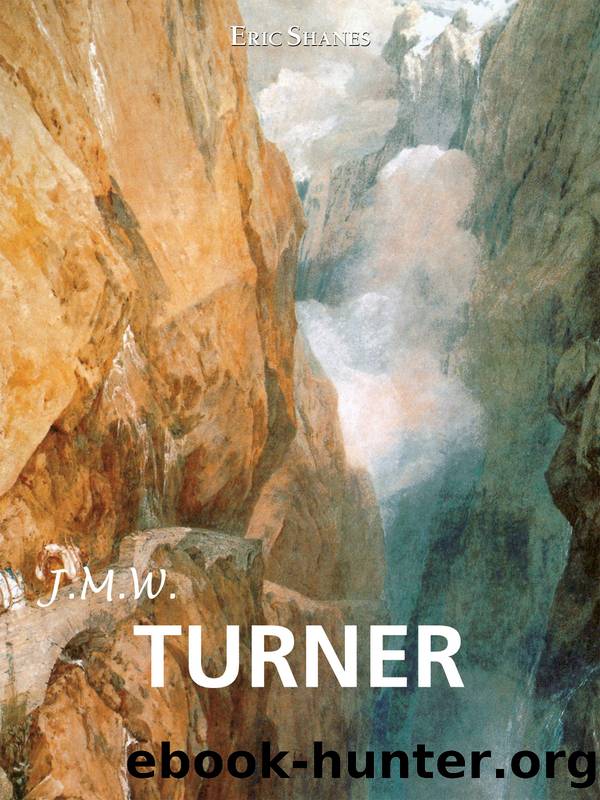J.M.W. Turner by Eric Shanes

Author:Eric Shanes [Shanes, Eric]
Language: eng
Format: epub
Publisher: Parkstone International
31. Ulysses deriding Polyphemus â Homerâs Odyssey, 1829. Oil on canvas, 132.5 x 203 cm. Turner Bequest, National Gallery, London
In Book IX of Homerâs Odyssey, Odysseus â of which name Ulysses is the Latinized form â is trapped with twelve of his men in the cave of the one-eyed giant, the Cyclops. The monster eats two members of the crew every dawn and dusk. After getting their captor drunk, Ulysses and his remaining companions poke out his eye with a sharpened, heated stake. They then escape at dawn by clinging to the undersides of a flock of sheep and rams belonging to their gaoler.
At the top-left the blinded Cyclops clutches his head in one hand and waves in anger with the other; far below him Ulysses stands by the mizzenmast of his ship and âderidesâ him in return. On the mainmast of the vessel a flag bears the name of Odysseus in Greek, while another banner represents the Trojan horse. To the left of the ship is a fiery cavern; this was surely intended to link the Cyclops to primordial subterranean forces, which in Turnerâs day were considered to be the source of such mythical creatures.
Because some clouds on the horizon to the right of the sun are shaped to look like the heads of horses, the orb doubles as the sun-god Apollo being pulled aloft in his chariot. Turner probably borrowed the notion of these clouds/Apollonian horsesâs heads from Poussinâs painting Cephalus and Aurora (National Gallery, London), in which they similarly appear. In shape the heads themselves clearly derive from an equine head that once adorned the east pediment of the Parthenon, which Turner knew from the Elgin marbles. At the prow of Ulyssesâs vessel phosphorescent nereids hold aloft stars, Phosphorus being the son of Aurora (who symbolizes Dawn), and thus the personification of the morning star. The luminescence indicates Turnerâs continuing interest in all types of visual phenomena. His enduring love of reflected light may be seen in the gorgeous colours arrayed across the shadowed side of Ulyssesâs ship.
It is commonly assumed that Turner represented the actual escape of Ulysses here, but that is incorrect. When Ulysses escapes, the Cyclops hurls huge boulders after him into the sea but such rocks are not visible, although the great rock-arches in the distance might allude to them. Instead, the Greek hero is now following his fleet, as we can see from the ships on the right and their wakes running across the bottom of the image. The timing is therefore dawn on the day after the escape of Ulysses, which is the precise time given by Homer for the heroâs departure from the land of the Cyclops.
Download
This site does not store any files on its server. We only index and link to content provided by other sites. Please contact the content providers to delete copyright contents if any and email us, we'll remove relevant links or contents immediately.
I Have Something to Say by John Bowe(3458)
Einstein: His Life and Universe by Walter Isaacson(1952)
What Happened to You? by Oprah Winfrey(1714)
Doesn't Hurt to Ask by Trey Gowdy(1588)
Solutions and Other Problems by Allie Brosh(1279)
American Dreams by Unknown(1212)
Disloyal: A Memoir by Michael Cohen(1191)
The Silent Cry by Cathy Glass(1071)
Infinite Circle by Bernie Glassman(1007)
Talk of the Ton by unknow(1005)
Don't Call it a Cult by Sarah Berman(996)
Group by Christie Tate(986)
Home for the Soul by Sara Bird(980)
Before & Laughter by Jimmy Carr(831)
Severed by John Gilmore(822)
Total F*cking Godhead by Corbin Reiff(812)
Ghosts by Dolly Alderton(808)
The Book of Hope by Jane Goodall(788)
Searching for Family and Traditions at the French Table by Carole Bumpus(779)
